This satellite photo shows three wildfires near Reno, Nevada as seen by a satellite July 5, 2017 — the Earthstone, Truckee, and Winnemucca Ranch Fires. The burned areas appear very dark and the red dots represent heat.
Category: Uncategorized
July fire causes evacuations west of Zortman, Montana
At 6 p.m. on Thursday the incident management team reported that the fire had burned 8,381 acres.
Above: Firefighters on the July Fire near Zortman, Montana
(Originally published at 12:28 p.m. MDT July 6, 2017)
(Updated at 12:50.m. MDT July 7, 2017)
Here is another updated map of the July Fire at Zortman, Montana current as of 3:30 a.m. MDT July 7, 2017. Click the map to see a larger version. We will post additional information when it becomes available.
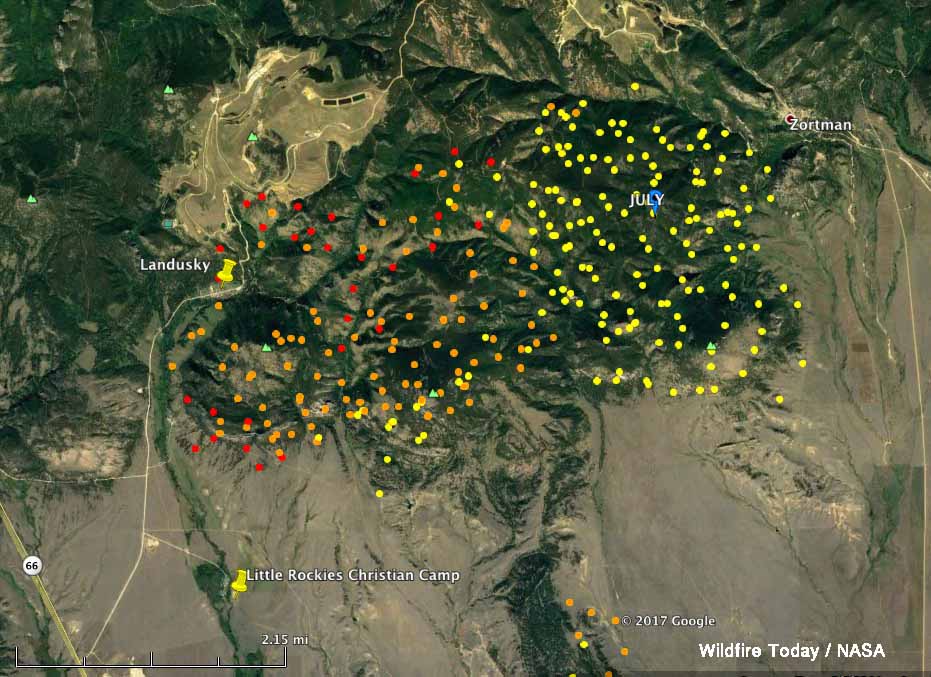
****
(Updated at 6:04 p.m. MDT July 6, 2017)
The July Fire in northern Montana west of Zortman was very active Thursday. A change in wind direction pushed the fire to the northwest in the general direction of the community of Landusky and the Little Rockies Christian Camp. A mandatory evacuation is in effect for Landusky; the camp is currently vacant and the caretaker has left. The fire is east and southeast of both locations.
The weather forecast for the fire area at 3,600 feet elevation predicts the wind out of the southeast will continue on Thursday, blowing at 9 mph gusting up to 15. The temperature will top out at 90 degrees with a minimum relative humidity of 20 percent. The actual conditions at Zortman at 3:30 p.m. were 86 degrees, 20 percent RH, and winds out of the east and southeast at 8 to 11, gusting to 18.
In the updated map below (click it to see a larger version) which shows data from 1:32 p.m. MDT on Thursday, the fire has moved further to the west and appears to be less than a mile away from Landusky.
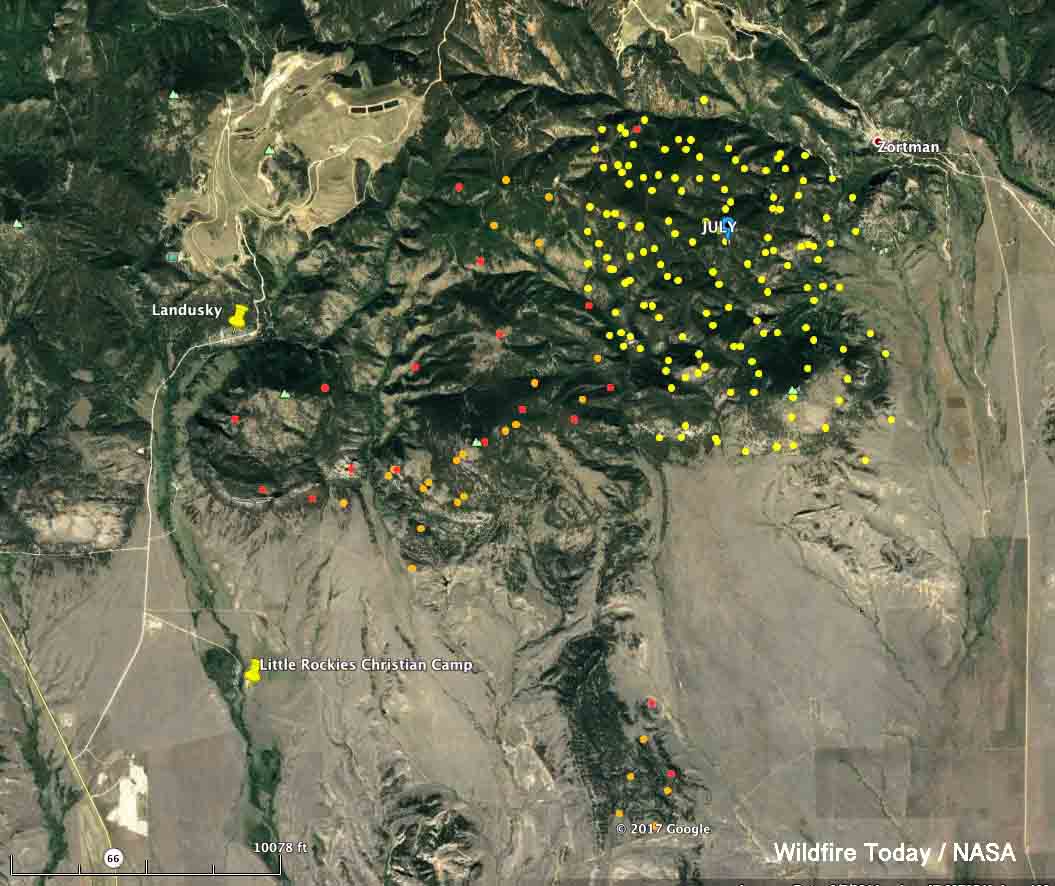
At 6 p.m on Thursday it had burned 8,381 acres, which is about four times the last reported acreage.
A Type 2 incident management team assumed command of the fire at 6 a.m. Thursday.
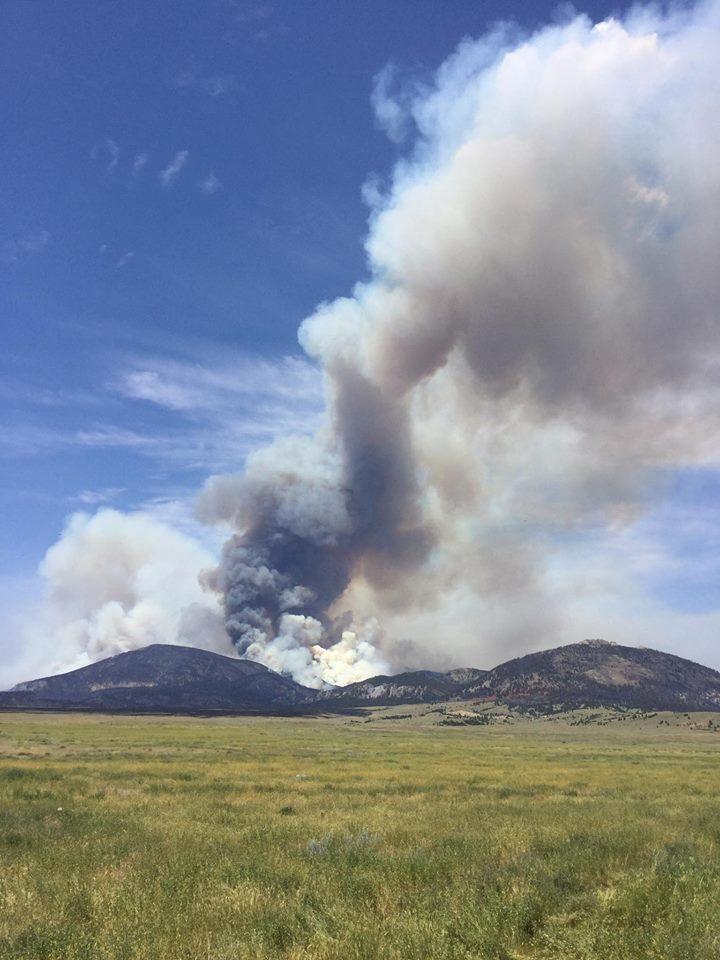

Four wildfires in Reno area have burned about 115,000 acres
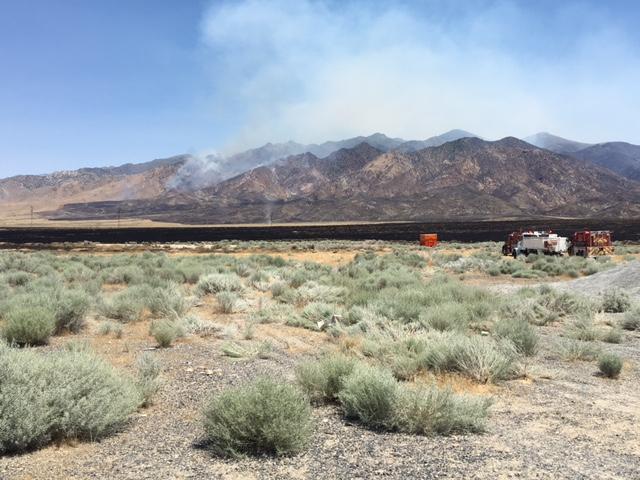
(Originally published at 10:09 a.m. MDT July 6, 2017)
Four large wildfires in the Reno/Sparks, Nevada area have burned a total of about 115,000 acres since the first ones started July 3. Brook Chadwick’s Type 2 incident management team will be assuming command of the Earthstone, Truckee, and Winnemucca Ranch Fires.
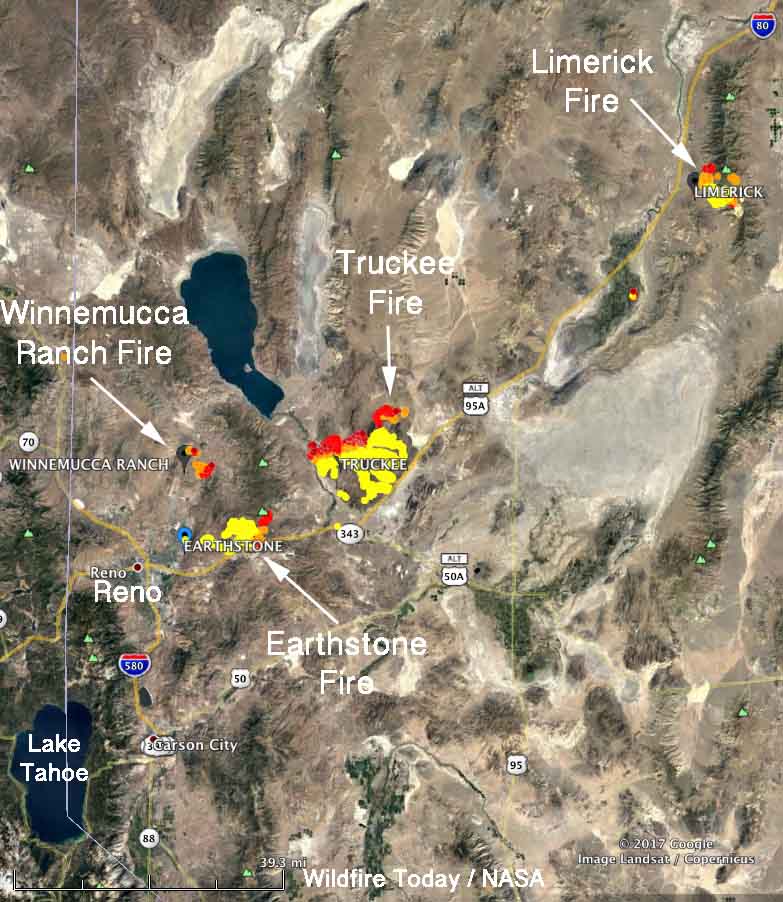

Earthstone Fire, 26,785 acres, just northeast of Reno/Sparks.
Information from Inciweb current as of about 8 p.m. MDT July 5, 2017:
“The Sierra Front Type 3 Incident Management Team assumed control of operations [presumably on Wednesday] and brought in additional resources, including two fire engine strike teams, to allow the releasing of some local fire crews to return to their home districts. A Type 2 Incident Management Team remains scheduled to assume command of the incident on Thursday morning.
Three additional fixed wing aircraft, including one Very Large Air Tanker (VLAT), made retardant drops today. Two Super Scooper air craft, requested from Alaska, are still on order and may arrive as early as Friday, bringing the total number of aircraft on the incident to 18.
Currently, there is no immediate threat to structures; however, residents of the Wadsworth area are encouraged to remain vigilant for the possibility of evacuation and complete their preparations as the head of the fire is now about 10 miles west of the town. Impacts to I-80 are expected in the vicinity of the USA Parkway within the next 24 hours.”
Truckee Fire, 70,546 acres, 28 miles northeast of Reno. Not much information is available, but it is exhibiting extreme fire behavior as it burns in brush and short grass in above normal temperatures and single-digit humidities.
Winnemucca Ranch Fire, 3,000 acres 8 miles north-northeast of Reno. Five structures have been destroyed on this fire and another 175 are threatened. Numerous animals and livestock have been evacuated along rural roads. The fire managers identified competition for firefighting resources as a problem.
Limerick Fire, 14,656 acres 94 miles northeast of Reno and 15 miles northeast of Lovelock. Two outbuildings have burned.
Information from Inciweb current as of about 9:40 a.m. MDT July 6, 2017:
“Firefighters stayed on the fire last night and were able to hold the fire line at the ridge to the south of Wright’s Canyon. Snow is still in the higher elevations and greener grass has helped keep the fire on the ridgetop.
Potential fire weather is predicted for the weekend and a structure protection group has been established as a contingency for active fire behavior.
Crews completed burn outs in the southeast corner of the fire yesterday and were able to connect containment lines to the dozer line near Golden Gate Hill. Crews will continue to secure fire line and begin mop up in the area near Couer Rochester Mine. Fire crews will continue to put in containment line on the eastern side of the fire working their way north.
Limerick Road is open to firefighter and mine traffic only.”
The maps below are forecasts for wildfire smoke at 5 p.m. MDT on Thursday.
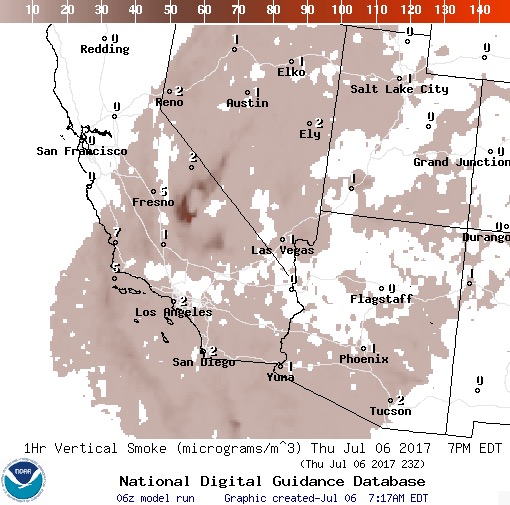
****
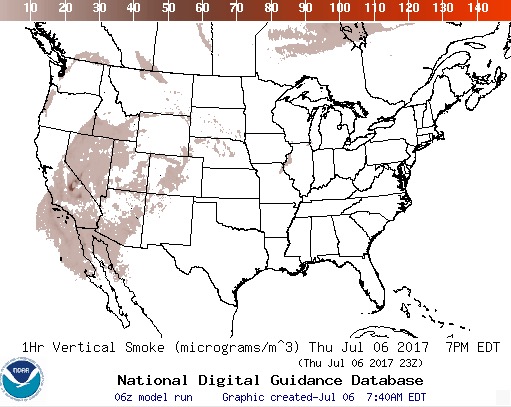
Wildfire smoke forecast for 5 p.m. MDT July 6, 2017
Peak 2 Fire near Breckenridge slowed overnight
Above: Map of the Peak 2 Fire (shown in pink) created by the incident management team at 9:03 p.m. MDT July 5, 2017.
(Originally published at 7:55 a.m. MDT July 6, 2017)
The Peak 2 Fire two miles north of the ski runs at Breckenridge, Colorado slowed late Wednesday afternoon and at 7 a.m. Thursday showed very little vigorous fire activity.
At 7 p.m. Wednesday Colorado’s Multi Mission Aircraft mapped it at 84 acres.
Structures are threatened and evacuations are in effect for the Peak 7 housing development.
The photo below was posted at 6:41 a.m. Thursday by Carol McKinley.
A mile away from the #Peak2Fire shows smoke but few flames. Breckenridge is crossing its fingers for calm winds. pic.twitter.com/EO1v6K1umJ
— Carol McKinley (@CarolAMcKinley) July 6, 2017
The fire was reported at about 11 a.m. Wednesday near the ski resort 50 air miles west of Denver. Aircraft worked the fire that afternoon, along with eight Boise smokejumpers and a hotshot crew. Additional resources have been ordered.
At a media briefing Wednesday it was announced that a Type 1 Incident Management Team would arrive at the fire on Thursday.
The weather forecast for the fire area at 10,000 feet calls for 78 degrees, 26 percent relative humidity, and northwest winds of 8 mph gusting to 13.
The video below was shot Wednesday before the fire activity slowed late in the afternoon.
And below, another photo shot during the height of activity on the Peak 2 Fire near Breckenridge at 3 p.m.
#Peak2Fire yesterday 3:00 pic.twitter.com/dL5KToocTJ
— Geefer Man (@geefer) July 6, 2017
Peak 2 Fire causes evacuations north of Breckenridge, Colorado
In the map above of the Peak 2 Fire, the red dots represent heat detected by a satellite at 3:54 p.m. MDT July 5, 2017.
(Originally published at 6:41 p.m. MDT July 5, 2017)
(Updated at 7:25 p.m. MDT July 5, 2017)
The Peak 2 Fire spread rapidly after it was reported just after 11 a.m. Wednesday morning between Breckenridge and Frisco near popular ski areas 50 air miles west of Denver. It is 2 miles north of the northernmost ski runs at Breckenridge.
At 5 p.m. fire officials estimated the size at 80 acres. According to Summit County the community of Peak 7, approximately 463 residences, is under evacuation. Residents of Breckenridge, Gold Hill and Silver Shekel have been asked to prepare for evacuation.
No structures have been destroyed and Highway 9 is open.
Aircraft have been working the fire, as well as eight Boise smokejumpers and a hotshot crew. Additional resources have been ordered.
The fire is being managed under the Unified Command of the US Forest Service, the Summit County Sheriff, and the Red, White and Blue Fire Protection District. Bill Jackson the local US Forest Service District Ranger on the White River National Forest said in a 7 p.m. briefing that a Type 1 Incident Management Team will assume command at noon on Thursday.
There are reports that late in the afternoon the fire activity decreased, but below are photos from earlier in the day as the fire was spreading more rapidly.
View of #Peak2Fire around 3:00MT. Huge flames visible from miles away. Impressive response by the Forest Service pic.twitter.com/s8C79L5Gmg
— Jordan Riek (@jordanriek) July 6, 2017
Holy crap… pic.twitter.com/LZY9JXVXJT
— Jack Queen (@jackqueen_) July 5, 2017
Still plenty of smoke but cautious optimism here that #Peak2Fire has settled down for the night. Do a rain dance! pic.twitter.com/RJG0dhA6yZ
— Jack Queen (@jackqueen_) July 6, 2017





